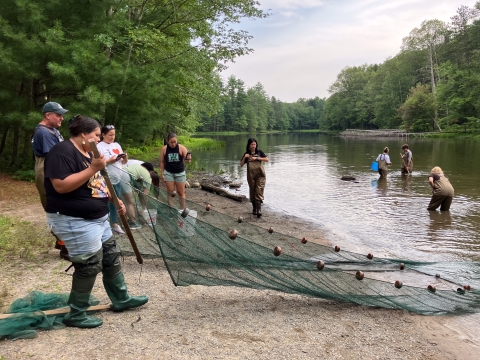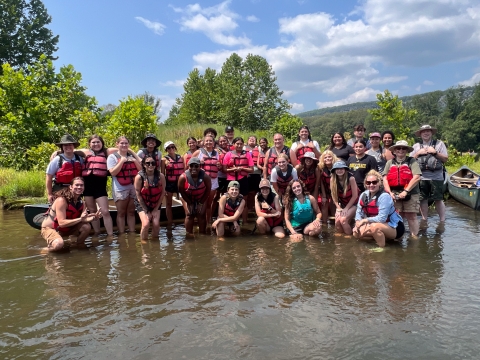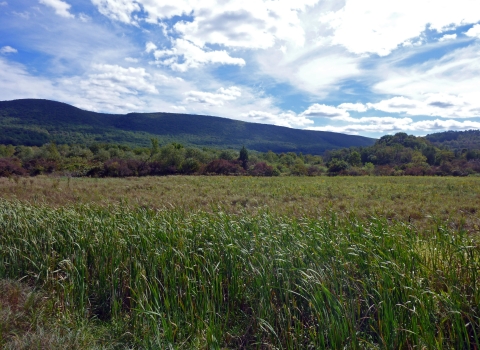Since time immemorial, Indigenous peoples have cared for the land today’s American public live, work, and recreate on.
The Service has a trust responsibility for federally recognized Tribal Nations and must consider whether our proposed actions will affect Tribal interests. We coordinate best practices for landscape conservation and cultural and historic preservation in accordance with federal laws and our Native American Policy. Our decision-making is enhanced by Tribes’ Traditional Ecological Knowledge — or Indigenous Knowledge — which is the evolving wisdom and experience acquired by Indigenous peoples over thousands of years, through their direct contact with the environment.
But how can Indigenous communities that were forcibly removed from their ancestral homelands give substantial information on how to care for them?
Three Lenape Tribes facing this conundrum wanted to reconnect their youth with their ancestral homeland in the Delaware River Watershed. Thanks to some guidance from the U.S. Fish and Wildlife Service and an America the Beautiful Challenge grant, the Tribes can make this dream a reality.
Lenape Tribes' Homelands
During the 19th century, three Lenape Tribal Nations were forced by war, disease and exploitative treaties to leave the territories that had supported their ancestors for millennia. Called the Lënapehòkink, these territories include modern northeastern Delaware, New Jersey, eastern Pennsylvania along the Delaware River watershed, New York City, western Long Island and the lower Hudson Valley.
Following a painful period of westward removals, the Delaware Tribe and Delaware Nation resettled in Oklahoma, and the Stockbridge-Munsee Community resettled in Wisconsin. They are the three federally recognized Lenape Tribal Nations in the United States.
Partnering to find solutions
At a routine meeting with agency staff in 2022, Lenape representatives remarked on the difficulty of providing Traditional Ecological Knowledge about land they were removed from generations ago. While a grant from the National Park Service had funded trips for Lenape to visit their ancestral homeland in the Delaware Watershed, that program had been discontinued.
The Tribes would have to seek a different route to Lënapehòkink.
Christina Ryder, wildlife biologist with our Chesapeake Bay Field Office who connects Tribes with federal grant resources, knew that Tribes face significant hurdles to funding such efforts.
“Federal money’s hard to get and application processes can be convoluted and difficult,” Ryder said. “Some grants need matching funds, but many Tribes lack the capital to match the federal dollar.”
Fortunately, Ryder directed the Tribes to a new funding source that could help – the America the Beautiful Challenge grant. Administered by the National Fish and Wildlife Foundation in conjunction with the U.S. Department of the Interior and other agency partners, the program encourages applicants to develop diverse, landscape-level projects that showcase cumulative benefits to fish and wildlife, engage with and benefit underserved communities, and connect people with nature.
Ryder and her team provided technical assistance to help the Tribes apply for the grant and in November 2022, they received $723,200 in funding. The grant’s match requirement was covered by a contribution from Native Americans in Philanthropy, a network of Native and non-Native nonprofits, Tribal communities, foundations and community leaders committed to sharing resources in the Native tradition of reciprocity.
Together, the three Tribes resolved to create a fellowship program to provide opportunities for Tribal citizens, particularly young adults, to discover new facets of their heritage by visiting the places their ancestors lived and taking part in immersive educational programming focusing on the ecology and cultural resource management of the Lënapehòkink.
Plans for the future
With funding secured, the Tribes got to work. The grant allowed for the creation of four full-time positions to coordinate the fellowships. To gain a better understanding of what the youth desire from their fellowships, each Tribe recruited three to six enrolled citizens aged 14 to 30 to participate in youth advisory groups to meet regularly to discuss the framework of the program. Participants received stipends to encourage commitment.
The advisory groups provided input on topics ranging from the recruitment process to the content of the work to how much fellows should be paid.
One thing was clear — to truly form their perspectives on the fellowship framework, the advisory group members needed to be in the Lënapehòkink in person.
In July 2024, the three Lenape Tribal Nations came together for the Lenapehoking Youth Conference at Delaware Water Gap National Recreation Area. Citizens from the sister Nations enjoyed canoeing, visiting important historical sites, viewing artifacts, attending education sessions, telling stories around the fire, and even touching an eel.
Sarah Borges, project planner for the Stockbridge-Munsee Community, says this grant allowed for the first meeting of youth from all three Tribes since the previous funding ran out. “I’m glad to see the process itself has already been valuable and enjoyable for them to connect to their heritage,” she noted.
The youth weren’t the only ones to benefit from visiting Lënapehòkink.
Bear Tompkins, youth coordinator for the Delaware Tribe of Indians, had his first trip to the Native lands when he attended the conference alongside his Tribe’s youth group. Though he had appreciated the Tribe’s heritage throughout his life, he “felt more connected than ever” to his ancestors when in the Lënapehòkink.
From planning to implementation
Because the Tribes’ ancestral homelands are now a mosaic of public and private ownership, the program will rely on collaborative partnerships with federal and state agencies and universities within the Lënapehòkink that can augment the fellowship experiences.
Project leaders of each Tribe will synthesize information from the youth planning groups and create the framework for the fellowship program, which is expected to launch in the summer of 2025 pending continued funds, reestablishing the connection between Tribal citizens and their homeland.
Bear Tompkins believes it was meant to be.
He fondly recalled the beginning of the canoe trip during the youth conference, when an eagle soared overhead.
“Our entire group let out war cries at the sight,” Tompkins recounted. “We saw it as a sign that it was leading us on the journey.”
At the conclusion of the trip, he found an eagle feather.
“With the eagle and then the feather, it was like two bookends to the trip,” he recalled. “An acknowledgment from our ancestors that they were with us all along.”










